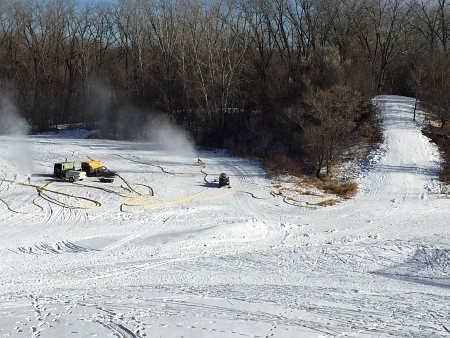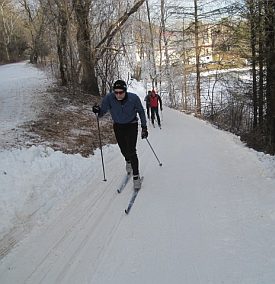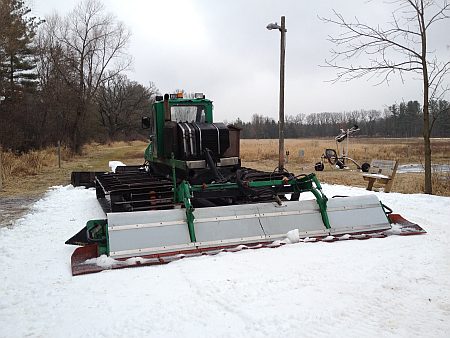Snowmaking Around the Region
Given the ephemeral nature of snow and the unpredictability of Midwestern winters, man-made snow can save a ski season in lean snow winters. With the National Weather Service predicting a major El Nino this year, a little extra man-made snow could make the difference between a white and a brown ski season, between a good and a bad year.
One big problem with snowmaking, however, is cost. Major downhill ski resorts spend anywhere from $500,000 to $3.5 million per year to make man-made snow. Snowmaking consumes expensive and limited resources – water, diesel fuel and electricity – driving up the costs. Cross country ski areas, unlike major downhill destinations, simply cannot afford or justify these high costs.
 Even so, some lower cost snowmaking alternatives exist and operate at cross country venues around the Upper Midwest. Edina High School runs two snowmaking guns on the Hornet Hiihto trails, which cost the program $2000 per gun. According to Craig Jarvinen, an assistant coach with the team, the 1600 feet of snow hose is their single most expensive item. “If we had to purchase that much today, it would cost about $6000,” Jarvinen said. So all totaled, Edina High has about $8000 of snowmaking equipment. The city of Edina has lent the team a third of their snow hose and lets them use their air compressor. Last winter, their operating costs, mostly diesel fuel, ran to almost $2000.
Even so, some lower cost snowmaking alternatives exist and operate at cross country venues around the Upper Midwest. Edina High School runs two snowmaking guns on the Hornet Hiihto trails, which cost the program $2000 per gun. According to Craig Jarvinen, an assistant coach with the team, the 1600 feet of snow hose is their single most expensive item. “If we had to purchase that much today, it would cost about $6000,” Jarvinen said. So all totaled, Edina High has about $8000 of snowmaking equipment. The city of Edina has lent the team a third of their snow hose and lets them use their air compressor. Last winter, their operating costs, mostly diesel fuel, ran to almost $2000.
The Edina snowmakers convert about 15 to 30 gallons of water per minute into snow given the weather conditions. Fan snowmakers can turn up to 250 gallons of water per minute into snow but these units cost about $70,000 each, which demonstrates two of the main points of snowmaking – the more money you spend, the faster and easier it is to make snow.
Once the snow has been blown into piles, it has to be moved around and formed into ski trails, another problem for small budget operations. A Pisten Bully can do this (huge expense), and Yuriy Gusev, CEO of CXC, uses end loaders and dump trucks to move snow at their events, another big expense if hiring it out. Edina avoids this expense by hand shoveling, by simple brute labor, to cover a roughly 1/2K snowmaking loop. Jarvinen also suggests doubling back on trails, putting the loops close together. “Densely packed trails make for easier and cheaper snowmaking,” Jarvinen stated.
The Vasaloppet USA in Mora, Minn, just this year invested in snowmaking equipment, according to Wade Weber, a past president and current board member of the Vasaloppet ski race. The initial equipment, a single Nessy gun from the Swiss company Bachler, as well as hoses, pumps, controls and sled, will cost nearly $50,000 and make snow for the Nordic Center’s lit-loop. “The key belief is to spend more on energy efficient equipment,” said Weber, “which costs more, but will provide much lower operating costs into the future.” Weber expects operating costs to be under $1000 per year, and the Vasaloppet already has several large donations to cover the initial purchase costs.
Down the road, Weber hopes the system can be expanded to make snow on 15 kilometers of trail so the Vasaloppet, which has faced several years of snow drought, could ski three 15 km laps for a marathon race in low snow years. “The system design is such that we can expand it in the future, by installing additional pumps, and a permanent piping system below grade with hydrants along the trail,” said Weber. “Our concept was to create a system that we can learn on, without investing in components that are not expandable for the future.”
Making snow on a three-kilometer loop will not immediately affect the Vasaloppet race, but for now, it will be a boon for local skiers looking for early season snow, particularly high school teams. Consistent snow obviously increases participation rates in local programs.
 Five years ago, the Winona Ski Club started making snow on the local trails at St. Mary’s University, according to Brad Skillicorn, president of the club. “We live in the banana belt of skiing,” said Skillicorn. “Without snowmaking, we wouldn’t have had skiing in Winona at least three of the past five years.” Since the club makes snow, they can confidently promote high school and youth cross country skiing. Without snowmaking, “skiing would melt away for the next generation.”
Five years ago, the Winona Ski Club started making snow on the local trails at St. Mary’s University, according to Brad Skillicorn, president of the club. “We live in the banana belt of skiing,” said Skillicorn. “Without snowmaking, we wouldn’t have had skiing in Winona at least three of the past five years.” Since the club makes snow, they can confidently promote high school and youth cross country skiing. Without snowmaking, “skiing would melt away for the next generation.”
The Winona Ski Club has two guns and tries to move a minimal amount of snow. According to Skillicorn, they’ve sought “to get away from piling and moving snow.” The narrow St. Mary’s trails have significant vertical and are built into a hillside, which makes piling and moving snow even more difficult, especially to the upper part of the trail.
So the club buried piping and electrical power, which took a significant investment. Including investments to the trail, Skillicorn estimated the club spent close to $70,000. Those costs were also reduced from local people volunteering their labor and donating equipment. “Without that support, our investment costs would have been at least three times higher and likely not achievable for our community,” said Skillicorn. The City of Winona also provides water at no charge up to a set limit.
Knicker Nordic, a ski club in Wausau, Wis., was initially founded by John Hugus to host a JNQ race, but with the only open date on the schedule in mid-December, Hugus had to guarantee snow. Hence, the man-made snow in Wausau at Greenwood Hills Golf Course.
According to Dave Hugus, John’s brother and resident snowmaker for Knicker Nordic, the club runs two SMI Pole Cat Snow Guns. The system uses pond water pumped at 300 psi, providing up to 150 gallons per minute for each gun. A Pisten Bully moves around any snow as necessary.
“I am guessing the initial investment was around $90,000,” said Hugus. “That includes guns, pump, wire, hoses, trailer (to move guns), valves, motor starter, miscellaneous plumbing and electrical equipment. Equipment such as ATV's, snowmobiles and a tractor or skid steer are also needed.” Yearly operational costs vary depending on the weather, but Hugus said yearly electrical costs vary from $1200 up to $2000 in a warm winter. Costs also depend on the amount of volunteer labor available.
“Snowmaking adds a new dimension to cross country skiing,” said Hugus. “It allows the community to ski at the same time as downhill ski hills open for the season.” Skiing has opened as early as the second week of November on a 2.5 km loop at Greenwood Hills, providing high school ski teams, youth programs and citizen skiers weeks of skiing before natural snow areas open. Hugus noted the man-made snow held up a few years back even during a weekend of heavy rain at the JNQ race.
Dave Hugus in partnership with CXC made snow last year for the IPC event in Cable and will be again making snow at Telemark for the Junior National races there in March.
 In 2007, the Wisconsin DNR along with the Friends of Lapham Peak teamed up to install snowmaking on an initial .6 km loop at the Lapham Peak Unit of the Kettle Moraine State Forest. Now in its tenth year of snowmaking, this loop has grown to 1.5 km. Lapham Peak cools their water in a pond then pumps it through hoses to high efficiency SMI Kid PoleCat snow guns. When the snow is piled up, groomers move it with a Snow Cat. The Friends of Lapham Peak hope to eventually expand the snowmaking to a full three kilometers.
In 2007, the Wisconsin DNR along with the Friends of Lapham Peak teamed up to install snowmaking on an initial .6 km loop at the Lapham Peak Unit of the Kettle Moraine State Forest. Now in its tenth year of snowmaking, this loop has grown to 1.5 km. Lapham Peak cools their water in a pond then pumps it through hoses to high efficiency SMI Kid PoleCat snow guns. When the snow is piled up, groomers move it with a Snow Cat. The Friends of Lapham Peak hope to eventually expand the snowmaking to a full three kilometers.
This is the farthest south snowmaking operation in this article, and sometimes is the only trail system with snow for skiers in southern Wisconsin and northern Illinois. In 2013-2014, Lapham Peak had over 100 days of skiing on the man-made snow. This reliable snow has engendered several programs, including Peak Nordic Kids.
There are a number of other snowmaking projects are in the works in the Upper Midwest, including sweeping plans in Duluth for the Grand Avenue Nordic Center, a brand new XC trail system, with snowmaking capability. The city and the Duluth Cross Country Ski Club are partnering in this part of the $50 million Western Waterfront project, and the nordic center would be housed at the new Grand Avenue lodge at the base of Spirit Mountain. The cross country trails would also share some of the snowmaking capability of Spirit Mountain’s alpine snowmaking system.
The city of Rochester has ambitious plans to light and make snow on a three to five-km loop at Gamehaven Regional Park in the southeast part of the city. The Rochester Active Sports Club (RASC) is heading up the snowmaking project. According to Steve Greymont, an RASC board member, local skiers drive to the Twin Cities in poor winters to ski on the man-made snow there, demonstrating that the demand for snowmaking in Rochester is high. RASC hopes to fund the snowmaking and lighting with private donations, the city budget, user fees and grants.
Today, more than ever, cross country skiers and ski programs desire and sometimes demand reliable snow. Other than trail systems in the lake effect snow belts of Michigan’s UP and the North Shore of Minnesota, reliable snow, particularly early in the season, means man-made snow.
 | About the author... Former member of the Skinnyski.com Race team, Mark Parman lives in Wausau, Wis. and has skied 23 Birkies. He writes mostly about outdoor sports and has written for Sports Afield, Dirt Rag, Bicycle Times, Velonews and Silent Sports. |

